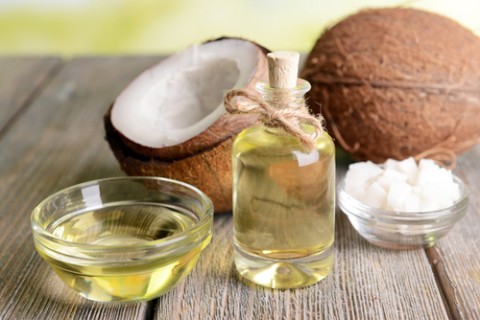Does ‘Oil Pulling’ Really Work?
 A few years ago, it seemed like you couldn’t go anywhere or read anything without hearing about "oil pulling"- the trend of swishing coconut oil around in your mouth for 20 minutes- supposedly to help purge toxins from your mouth and whiten your teeth. The trend seemed to die down for a while, but it’s starting to come back again thanks to social media sites like Instagram, which are chock-full of photos celebrities and beauty bloggers with perfect, gleaming smiles- many of whom credit those smiles to oil pulling. But is oil pulling really the miracle whitener it claims to be- and more importantly, is it safe? Here’s everything you need to know about this resurging trend.
A few years ago, it seemed like you couldn’t go anywhere or read anything without hearing about "oil pulling"- the trend of swishing coconut oil around in your mouth for 20 minutes- supposedly to help purge toxins from your mouth and whiten your teeth. The trend seemed to die down for a while, but it’s starting to come back again thanks to social media sites like Instagram, which are chock-full of photos celebrities and beauty bloggers with perfect, gleaming smiles- many of whom credit those smiles to oil pulling. But is oil pulling really the miracle whitener it claims to be- and more importantly, is it safe? Here’s everything you need to know about this resurging trend.
If you’re starting to feel like coconut oil is the new snake oil these days, you’re not alone. It’s everywhere, in everything, and if you so much as hint at an ailment on Facebook, chances are you have at least one friend who’ll recommend slathering the problem in coconut oil instead of seeing a doctor. It’s a suggestion that’s become so common, it’s become a running gag. When it comes to your teeth, coconut oil and oil pulling have a few benefits- but they’re not the miracle benefits everyone suggests.
First of all, oil pulling is not dangerous- provided you don’t swallow the oil during or after swishing. In some rare cases, people have actually developed pneumonia from swallowed oil. If you do oil pull, experts recommend you spit out the oil into a trash can, not down the toilet or sink, as the oil can coat your pipes and cause plumbing problems.
Now, onto the technical stuff. While oil pulling isn’t dangerous, it’s not exactly the miracle cure it's purported to be, either!
- Oil pulling can’t whiten your teeth. Yes, your friends may swear it makes their teeth look cleaner- and it does- but not because it is oil. But because swishing any clear liquid for 20 minutes will lift some staining. You would get the same benefits using plain old tap water!
- Oil Pulling isn’t better than brushing and flossing your teeth with toothpaste and floss (or a Waterpik). Even swishing for 20 minutes doesn’t guarantee that you’ll get food and plaque stuck between your teeth, so please don’t think because you oil pull you can skip those important steps. That being said, oil pulling is perfectly safe if you want to use it as a mouthwash to help loosen plaque and lift some light surface staining.
- Oil pulling can’t cure TMD. For someone with a TMJ disorder swishing that long could be extremely painful and is not advised. If you are experiencing TMJ pain, contact your dentist ASAP – don’t try to treat TMD yourself with a home remedy! You could end up doing more damage by unintentionally exacerbating the condition.
- You can use any oil. It doesn’t have to be coconut oil. To whiten teeth, you can use plain water, but if you really want to pull with oil, you could use sesame oil, grapeseed oil, or any other oil you have on hand.
- DO NOT let your kids oil pull. While oil pulling is not technically recommended for adults by dentists, it’s also not forbidden- but it is definitely not safe for kids. This is because there is a pretty good chance they will swallow some of the oil and put themselves at risk for pneumonia, or at very least, a stomach ache. If you’re concerned about your child’s brushing habits and think they could use a little extra help, ask your dentist for some tips to help. Some cool new tech devices can help encourage kids to brush that may be worth a try and won’t put them at unnecessary risk.
- Oil pulling DOES kill some of the bad bacteria in your mouth while leaving behind the good bacteria that mouthwash sometimes kills in addition to that bad bacteria. So, if you do want to oil pull, use it as a rinse- but please don’t quit your regular oral health care routine.
- And yes, you really do need to swish for 20 minutes at a time to get the full benefits.
If you have more questions about oral hygiene give Dr. Lederman a call at 516-882-1764. He'll be happy to help!



